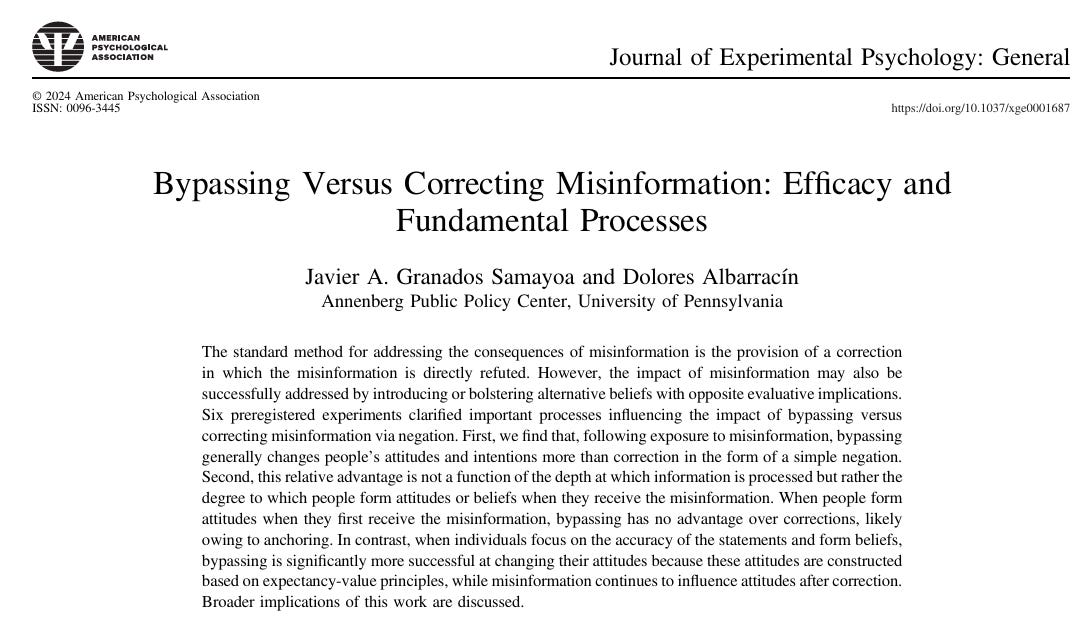"Bypassing" is a new way to counter misinformation, but how does it work?
A new study found that "bypassing" can counter misinformation without direct confrontation.
On my social media, I recently shared a study that described the benefits of bypassing: a newly studied strategy that was found to counter false information without needing to directly correct false claims. Many people seemed interested in this strategy, so I wanted to spend a little more time breaking down the paper and also share some more examples they used.
Bypassing is defined as “a response to misinformation that introduces or bolsters nonmutually exclusive alternative beliefs with opposite evaluative implication to that of the misinformation.” In other words, instead of directly countering an inaccurate statement about a topic that someone feels negatively about, you provide a positive and truthful statement on the same topic. For example, if someone claims GMOs (Genetically Modified Organism) are harmful to consume, you would “bypass” the inaccuracy by focusing on a positive and accurate statement about how GMOs help the bee population.
Through six experiments, the authors of this study found that bypassing is often more effective than simple, direct corrections in countering misinformation. The topics used for misinformation included claims that GMOs, 5G technology, and vaccines were harmful. The researchers assessed participants' attitudes by measuring their support for policies that restricted these topics after exposure to either a simple correction, bypassing, or no correction. Participants in the bypassing condition were significantly less likely to support restrictive policies, indicating that bypassing effectively reduced the influence of misinformation on their attitudes. Critically, this outcome measure does not specifically measure change in the inaccurate belief.
While this is still an encouraging result, there is a key limitation of when bypassing can work most effectively. When people form attitudes immediately upon encountering misinformation, bypassing offers no advantage over corrections, and this is likely due to anchoring effects. An anchoring effect is a cognitive bias where an individual's decisions or evaluations are heavily influenced by an initial piece of information (the "anchor"), even if it is irrelevant or inaccurate. Once the anchor is established, people tend to rely on it as a reference point and make insufficient adjustments away from it, leading to skewed judgments. People who are extremely ideologically committed to a certain belief also may not be as open to bypassing or any other type of fact-check.
Thus, bypassing is a technique to share more positive, truthful statements with someone who may have some skepticism about a topic but is still open to new information.
The study is paywalled and newly published in the Journal of Experimental Psychology, but you can read their study materials for free here. Importantly, you can see all of the stimuli they used in their studies. Here is one bypassing example they used for vaccine misinformation:
Misinformation: Aluminum in vaccines causes bone problems.
Correction: There is no evidence that the levels of aluminum in vaccines cause bone problems.
Bypassing: The aluminum in vaccines makes vaccines more effective at preventing disease
You can see here how these are very simple corrections. In summary, this study provides solid evidence that bypassing can reduce the impact of misinformation, but I wouldn’t say that it provides strong data for bypassing being better than corrections overall. As usual, many different strategies are necessary for combating misinformation across many different audiences and contexts. Please let me know if you found this article summary interesting and/or helpful and I will do more of them!
In other news, my book is finally available for pre-order online! The price is still in flux as we finalize the formatting/page count over the next month or so. I will make an official book announcement closer to when the book will be available and when all the information is finalized, but I wanted to share this update with all of you. The cover is finalized though!
For my paid subscribers, I did create a Substack chat where we can do some Q&A. Feel free to suggest future podcast guests and/or let me know if there are certain topics you want me to write about/discuss. I do have my first podcast guest interviews scheduled and I’m still on track to launch my podcast next month.
Thank you all for your support!



I'm glad @skipscorner had re-upped this as I had missed it when it came out originally.
Pretty cool!
I can't resist sharing a few relevant cites from my tiny sliver of interest - nicotine and relative risk perceptions across various nicotine products, plus a bonus one from the "field" of fertilization (winky face):
https://www.researchgate.net/publication/316456914_Nicotine_and_E-cigarette_Beliefs_and_Policy_Support_among_US_Smokers_and_Nonsmokers - disclosures are that my bride is the first author AND this journal has now imploded (but it was legit 8 years ago!!)
https://www.sciencedirect.com/science/article/abs/pii/S0306460311000608?via%3Dihub - self-promo warning as I'm a co-author but I really love this paper, particularly how it shows how perceptions of "value" incorporate risk judgments (eg, we really are affective evaluators and don't break down are judgments in to clear lanes of evaluations)
And, finally, if you've not read about Oga, then it is hot-damn time to read about Oga!
https://x.com/jgitchell/status/1540689264421195776
And my big disclosure: My employer, Pinney Associates, provides consulting services to Juul Labs on nicotine vapor for tobacco harm minimization.